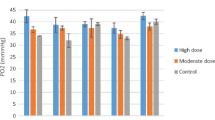Abstract
This work is focused on the course and changes of selected clinical and laboratory findings after nitrate administration in seven calves. The calves were 3–6 months old, were fed a solid diet and had an average body weight of 97 kg. Nitrates were administered intraruminally in a water solution of KNO3 at a dose of 0.5 g/kg of body weight. We observed the development and course of methaemoglobinaemia (% MtHb) in relation to the emergence of clinical findings, changes in body temperature, breathing and pulse rates, blood gases and acid–base balance. Various time trends as well as methaemoglobinaemia levels were recorded when values increased. The highest values of MtHb were found in the three youngest calves (67.5, 70.9 and 90.3 %), which were consequently treated by 1 % methylene blue solution because of marked clinical findings. Marked changes were observed in breathing and pulse rates, which correlated significantly with methaemoglobinaemia levels (P < 0.001). Significant effect of nitrate-induced methaemoglobinaemia was found on blood pH (P < 0.05), pO2 (P < 0.001) and O2 saturation (P < 0.01). Nitrate administration and formation of methaemoglobin did not affect the metabolic parameters of acid–base balance. Changing MtHb values correlated significantly positively with changes of blood pH (P < 0.01), breathing and pulse rates (P < 0.001) and negatively with pCO2 (P < 0.05), pO2 and O2 saturation (P < 0.001). The obtained results indicate a markedly different development and course of nitrate poisoning. More distinct changes in clinical findings were not observed until the methaemoglobinaemia levels were over 60 %. Methaemoglobinaemia resulted in failure of oxygen transport and hypoxaemia with a significantly negative correlation of both parameters. The achieved results contribute to the study of acute nitrate/nitrite poisoning in cattle and supplement the present knowledge by significant correlation relationships between methaemoglobinaemia levels and some clinical signs and metabolic indices.
Similar content being viewed by others
References
Asbury AC, Rhode EA (1964) Nitrite intoxication in cattle: the effects of lethal doses of nitrite on blood pressure. Am J Vet Res 25:1010–1013
Baranová M, Jacková A, Maľa P, Burdová O, Žežula I (2000) Methemoglobin levels in blood and transrenal passage of nitrates and nitrites in calves. Bulletin Vet Inst Pullawy 44:73–78
Birnbreier E (1991) Auswertung der Kenntnisse über die Nitrat/Nitrit Belastung von Nutztieren zur Ableitung von Toleranzkoncentrationen in Tränkwasser. Inaugural Dissertation, University of Veterinary Medicine Hanover
Bouda J, Jagoš P, Skřivánek M, Mužík J, Šupáková D (1986) Origin and course of methemoglobinemia in calves. Acta Vet - Brno 55:273–283
Bruning-Fann CS, Kaneene JB (1993) The effects of nitrate, nitrite, and N-nitroso compounds on animal health. Vet Hum Toxicol 35:237–253
Davis LE (1980) Nitrate intoxication. J Am Vet Med Assoc 177:82–83
Dixon RJ (2001) Clinical toxicology, 3rd edn. University of Sydney, Sydney, p 38
El Bahri L, Belguith J, Blouin A (1997) Toxicology of nitrates and nitrites in livestock. Comp Cont Educ Pract Vet 19:643–649
Haliburton J (1999) Nitrate poisoning associated with the consumption of forage or hay. In: Howard JI (ed) Current veterinary therapy food animal practice, 4th edn. Philadelphia, WB Saunders Co., Philadelphia, pp 278–279
Halsey LA (1998) Nitrates in forage cause cattle deaths: a common weed and uncommon circumstances. In: Florida beef cattle short course proceedings–managing nutrition and forages to improve productivity and profitability, University of Florida IFAS, Florida, pp 99–108
Homolka J (1971) Clinical biochemical examination methods (In Czech). Praha, Czech Republic, Avicenum, p 440
Horio M (1981) Experimental study on nitrate poisoning of ruminants by giving KNO3. Bulletin Nippon Vet Zootech College 30:225–229
Jacková A, Pleva J, Baranová M, Maľa P, Siklenka P (1992) Dynamics of methemoglobin levels in the blood of calves in relation to the ingested quantity of nitrates and the transrenal transport of nitrates. Vet Med (Czech) 37:493–500
Jacková A, Siklenka P, Pleva J (1999) Transrenal passage of nitrates and nitrites in calves. Arch Tierz Dummerstorf 42:235–239
Kelch WJ, Kerr LA (1997) Nitrate toxicosis in cattle due to careless handling of fertilizer. Large Anim Practice 18:41–42
Kemp A, Geurink JH, Haalstra RT, Malestein A (1976) Nitrate poisoning in cattle. 1. Discoloration of the mucous membrane as aid in the prevention of nitrate poisoning in cattle. Stickstoff 19:40–48
Kemp A, Geurink JH, Haalstra RT, Malestein A (1977) Nitrate poisoning in cattle. 2. Changes in nitrite in rumen fluid and methemoglobin formation in blood after high nitrate intake. Neth J Agric Sci 25:51–62
Knight AP (1985) The toxicology of sulfur and nitrate in ruminants. Bovine Pract 20:121–123
McQuirk SM, Semrad SD (2005) Toxicologic emergencies in cattle. Vet Clin North Amer - Food Anim Pract 21:729–749
Nicholson SS (2007) Nitrate and nitrite accumulating plants. In: Gupta RC (ed) Veterinary toxicology—basic and clinical principles. Elsevier, Waltham, pp 876–879
Radostits OM, Gay CC, Kenneth WH, Constable P (2007) Veterinary medicine—a textbook of the diseases of cattle, horses, sheep, pigs, and goats. Elsevier, Waltham, p 2156
Slanina Ľ, Slivka P, Struháriková J (1990) Transmammary transfer of nitrates and nitrites in ruminants and the level of methaemoglobinaemia in the blood of the young and their mothers. Vet Med (Czech) 35:647–656
Slanina Ľ, Slivka P, Struháriková J, Elbertová A, Chandoga P (1991) Methaemoglobinaemia in calves, mainly in the dam–calf relation and after experimental application of nitrates. Vet Med (Czech) 36:1–8
Wiesner E (1985) Nitrat-Nitrit-Vergiftungen beim Rind. Übers Tierernährung 13:83–112
Yeruham I, Shlosberg A, Hanji V, Bellaiche M, Marcus M (1997) Nitrate toxicosis in beef and dairy cattle herds due to contamination of drinking water and whey. Vet Hum Toxicol 39:296–298
Acknowledgements
This work was supported in part by VEGA scientific grant number 1/0812/12 from the Ministry of Education and by Slovak Research and Development Agency under contract number APVV-0475-10.
Author information
Authors and Affiliations
Corresponding author
Rights and permissions
About this article
Cite this article
Nagy, O., Paulíková, I., Seidel, H. et al. Clinical signs, blood gases and acid–base balance after nitrate administration in calves. Comp Clin Pathol 23, 647–652 (2014). https://doi.org/10.1007/s00580-012-1665-5
Received:
Accepted:
Published:
Issue Date:
DOI: https://doi.org/10.1007/s00580-012-1665-5




